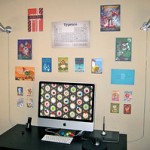“…a comfortable, balanced office shows signs of the hobbies, travels, relationships, or interests of the person within” (Ricci, 2005, p. 61).
Preserving those things that are meaningful to you transforms institutional drab into a reflection of your personal tastes, and into a place in which you feel comfortable. Personal embellishments do not have to be expensive – the photographer’s print that I purchased at a garage sale for example was $5.00, and my accessories (including a Yugoslavian crystal lamp) were also bought at second hand stores. Although the tulip picture framing far exceeded the cost of the original print, by doing so I was able to preserve it from sun damage, dust and yellowing, and general deterioration. Another display option isdigital framing, which provides a continuous cycling of your photographs in a space saving format.*
Both Ricci (2005) and Hemphill (2006) provide a great starting point for the aesthetic design of your work space. They suggest the following considerations:
- Furnishings are in proportion to the size of the room
- There is plenty of room for walking between furniture – minimum of 22″ for traffic paths.
- Your primary office chair has space to swivel and roll – 18″ between the back of the chair and wall
- Computer equipment, machines, and peripherals are easily accessible from your seated position, without having to reach or stretch.” (Ricci, 2005, p. 46). To tame the clutter beneath your computer, Cable Turtle (cableturtles.co.uk) helps to conveniently tuck tangled cords from sight (see “Tidy your cables,” (n.d.)), while Kable Flags (from organize.com) pictorially identify computer wires with vinyl tags
- Filing cabinets, shelves, and storage rooms are free of unidentified piles of paper and disks. (Hemphill, 1996, p. 141).
A comfortable chair in the office corner is great place for reading or sorting through papers. Other amenities aimed at comfort include a tea or coffeepot and accoutrements, combined with a drawer that is engineered for personal well-being. Breathnach (1995) argues for the importance of creating an “enjoyable nest,” as opposed to a “sterile environment” by keeping essential goodies like pain relief medication, tissues, breath mints, chocolate bars, and sewing kits on hand. I have found that storing bottled water, a teapot, and my favorite teas within a desk drawer saves both money and time.
_________________________________________________________________________________
*Based on their findings, Sanchez-Burks, Heaphy, Ashford, and Kim (n.d.), however argue that personal items like knickknacks and pictures should not exceed twenty-two percent of office contents.
_________________________________________________________________________________
References
Breathnach, S. B. (1995). A daybook of comfort and joy. New York: Warner Books.
Hemphill, B. (1996). Taming the office tiger: the complete guide to getting organized at work.Washington, D.C., Kiplinger Washington Editors.
Ricci, M. (2005). Organize your office in no time. Canada: Que Publishing.
Sanchez-Burks, J., Heaphy, E., Ashford, S., Kim, S. (n.d.). Non-work role references as an organizational taboo: Evidence of cultural boundaries and reinforcing mechanisms. Ross School of Business, University of Michigan, Paper No. 1041.
Tidy your cables. (n.d.). Retrieved at http://www.cableturtles.co.uk/.






Recent Comments